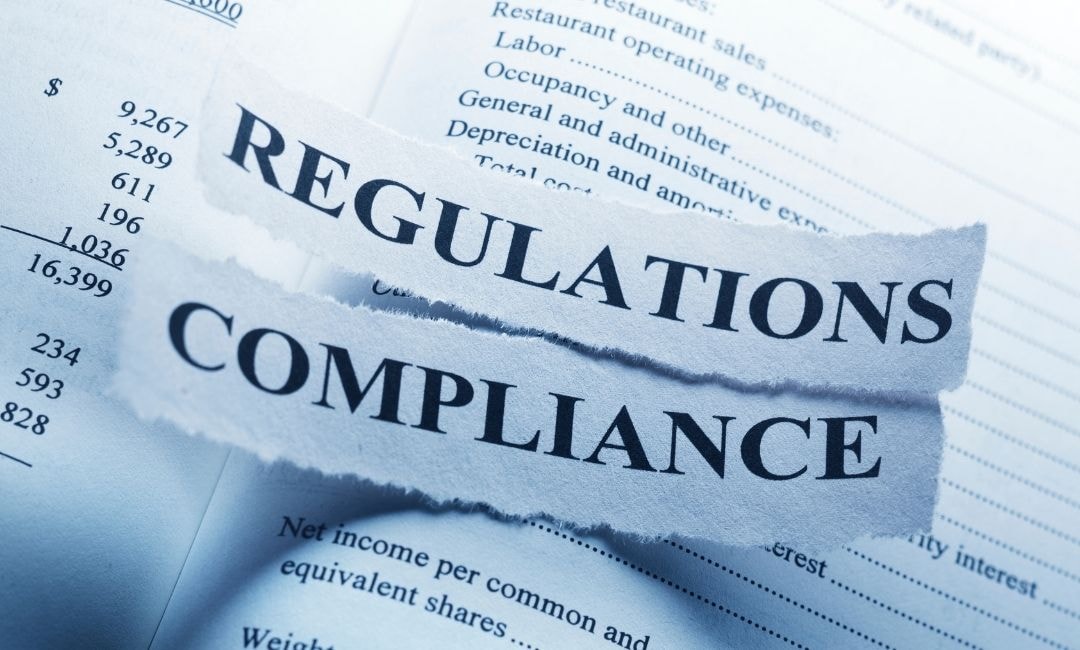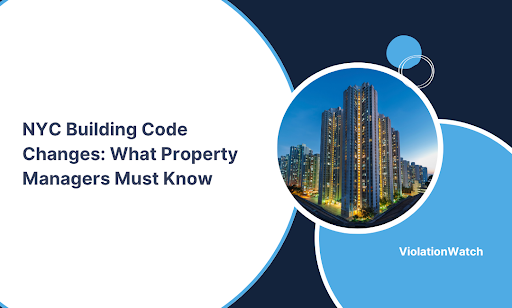Your building passed inspection last year. The tenants are happy. Your compliance record looks spotless. Then 2025 hits with a wave of new law updates that could turn your well-managed property into a violation magnet overnight.
New York City isn’t just tweaking a few minor rules—they’re implementing sweeping NYC building regulations across energy efficiency, fire safety, accessibility, and environmental standards. These updates will reshape how you manage properties, handle inspections, and maintain compliance.
The stakes are higher than ever. Miss a deadline, overlook a new requirement, or misunderstand a regulation, and you’re looking at hefty fines, legal headaches, and potentially unsafe conditions for your tenants. The NYC Department of Environmental Protection and other agencies are enforcing these rules strictly.
Here’s what we’ll cover to keep you ahead of the curve:
- Energy efficiency mandates that could require major building upgrades and new reporting obligations to reduce greenhouse gas emissions
- Fire safety protocol changes affecting everything from alarm systems to emergency procedures
- Accessibility requirements that extend beyond basic ADA compliance
- Environmental regulations targeting lead paint, air quality, and waste management
- Critical deadlines you cannot afford to miss throughout 2025
- Practical compliance strategies to avoid violations and reduce costs
- How ViolationWatch simplifies tracking and managing these new requirements across your entire portfolio
The property managers who master these changes will protect their investments and avoid costly surprises. Those who don’t will spend 2025 scrambling to catch up while dealing with violations that could have been prevented.
Energy Efficiency Mandates Reshape NYC Property Management
New York State and New York City’s 2025 energy efficiency regulations represent the most aggressive push toward carbon neutrality the city has ever implemented. Property managers now face mandatory compliance requirements that directly impact building operations, tenant costs, and long-term property values.
Local Law 97 Takes Full Effect
Buildings over 25,000 square feet must now meet specific greenhouse gas emissions limits or face substantial financial penalties. The law requires property owners to submit annual energy reports certified by registered design professionals by May 1, 2025.
Buildings that fail to meet 2025 emissions limits face fines starting at $268 per metric ton of CO2 equivalent over the limit. For a typical large residential building, this could translate to tens of thousands of dollars in annual penalties, significantly impacting energy costs.
New Reporting Requirements You Can’t Ignore
- Submit certified emissions reports to the Department of Buildings DOB by May 1
- Provide detailed energy usage data for all building systems
- Document any efficiency improvements or retrofits completed
- Maintain records of all energy-related maintenance and upgrades
Local Law 32 Expands Solar Requirements
The city now requires solar installations across schools and public buildings, with private buildings likely facing similar mandates in upcoming legislation. Property managers should prepare for potential solar requirements that could affect roof usage, structural loads, and electrical systems.
Building Emissions Caps Become More Stringent
The 2025 emissions caps are 40% more restrictive than previous years, with further reductions planned through 2030. Buildings must achieve an 80% reduction in emissions by 2050 compared to 2005 levels—the city’s goal for long-term sustainability.
Common compliance strategies include upgrading HVAC systems, improving insulation, installing energy-efficient windows, and switching to cleaner energy sources away from fossil fuels. Many property managers are discovering that proactive upgrades cost less than paying ongoing penalty fees. Energy benchmarking has become essential for tracking progress toward these goals.
Fire Safety Protocol Changes Demand Immediate Attention

The Department of Buildings has implemented comprehensive fire safety updates that affect inspection schedules, equipment requirements, and emergency procedures across all property types. These changes prioritize public safety for all New Yorkers.
Facade Inspection Requirements Get Stricter
Buildings taller than six stories now face more rigorous exterior wall inspection requirements. The Facade Inspection Safety Program (FISP) mandates that qualified exterior wall inspectors examine building facades every five years, with technical reports due within specific filing windows.
Cycle 10 FISP Filing Windows:
- Block A: File between February 21, 2025, and February 21, 2027
- Block B: File between February 21, 2026, and February 21, 2028
- Block C: File between February 21, 2027, and February 21, 2029
Missing these deadlines results in immediate violations and daily penalties until compliance is achieved.
- Gas Piping Inspection Penalties Increase: Buildings with gas piping systems must complete periodic inspections by certified professionals, often requiring a licensed master plumber. The new cycle requires inspections every five years, with failure to file Gas Piping System Periodic Inspection Certifications resulting in civil penalties of $5,000 per violation.
- New Energy Code Implementation: The updated NYC Electrical Code takes effect December 21, 2025, introducing stricter requirements for electrical installations, emergency lighting, and fire alarm systems. Property managers must ensure all electrical work performed after this date complies with the new standards.
- Buildings After Hours Schedule Changes: DOB borough offices now operate extended hours on the first and third Tuesday of each month from 4:00 PM to 7:00 PM. This change provides additional opportunities for property managers to address inspection concerns and file required documentation.
Accessibility Requirements Extend Beyond Basic Compliance
The 2025 accessibility updates introduce new standards that affect building modifications, tenant accommodations, and public area accessibility requirements. These changes ensure equal access for all residents in commercial buildings and residential properties alike.
- Major Building Definition Updates: The NYC Building Code now defines “major buildings” as structures 10 or more stories, 125 feet or more in height, or containing 75 or more dwelling units. These buildings face enhanced accessibility requirements that extend beyond federal ADA standards, particularly in public spaces.
- New Parapet Rule Affects Safety Access: Building owners must ensure annual parapet inspections by competent inspectors to identify hazardous conditions. This rule requires building owners to maintain detailed inspection records and address any safety concerns within specified timeframes.
- All-Electric Building Requirements: New buildings seven stories or fewer must be all-electric by December 31, 2025. Buildings larger than 100,000 square feet or taller than seven stories must be all-electric by December 31, 2026. These requirements affect both new construction projects and major renovation projects, fundamentally changing building designs.
- Parking Structure Inspection Mandates: Buildings with parking garages in Manhattan Community Districts 6, 9, 10, 11, and 12, plus Brooklyn locations, must complete structural inspections by Qualified Parking Structures Inspectors. These inspections must be filed with DOB by December 31, 2025.
- Enhanced Documentation Requirements: Property managers must maintain comprehensive records of all accessibility modifications, including:
- Detailed plans for any structural changes affecting accessibility
- Certificates of compliance for elevator and lift installations
- Documentation of reasonable accommodation requests and responses
- Records of accessibility-related tenant communications
- Finance records related to accessibility improvements
The new requirements emphasize proactive compliance rather than reactive responses to violations. Property managers who establish systematic tracking and documentation processes will find compliance significantly more manageable than those who address issues only when violations arise. This is particularly important for small business owners who may have limited resources for compliance management.
Environmental Regulations Target Multiple Compliance Areas

New York City’s 2025 environmental regulations create a comprehensive framework that addresses lead paint remediation, air quality monitoring, and waste management across all property types. These regulations carry significant financial penalties and require systematic compliance tracking to reduce emissions across New York City buildings.
Lead Paint Regulations Become More Stringent
The updated lead-based paint regulations expand beyond traditional requirements, focusing on cumulative environmental impacts and equitable access to safe housing. Property managers must now implement more rigorous testing, documentation, and remediation procedures in existing buildings.
Key Lead Paint Compliance Requirements:
- Annual lead paint inspections in buildings constructed before 1978
- Certified lead-safe work practices for all renovation activities
- Enhanced tenant notification procedures for lead-related work
- Detailed record-keeping of all lead paint testing and remediation
- Immediate reporting of lead hazards to the appropriate city agencies
Air Quality Monitoring Expands
Buildings must now monitor and report air quality metrics, particularly in areas with high pollution exposure. The regulations target buildings in environmental justice communities and require regular air quality assessments. This includes monitoring lighting systems for energy efficiency and their impact on indoor air quality.
Mandatory Air Quality Actions:
- Install air quality monitoring systems in designated buildings
- Submit quarterly air quality reports to the Department of Environmental Protection
- Implement corrective measures when air quality thresholds are exceeded
- Maintain ventilation systems to meet new air quality standards
- Document all air quality improvements and system upgrades
Waste Management Requirements Intensify
New waste management regulations require property managers to implement comprehensive recycling programs, reduce organic waste, and track disposal methods more accurately. These requirements must be integrated with existing zoning ordinances and local regulations.
- Waste Compliance Checklist:
- Establish organic waste separation programs for buildings with 10 or more units
- Implement recycling tracking systems for all waste streams
- Submit annual waste reduction reports to the Department of Sanitation
- Maintain contracts with certified waste management providers
- Document all waste diversion and recycling activities
- PFAS Reporting Takes Effect: Buildings must now report the presence of per- and polyfluoroalkyl substances (PFAS) in building materials and systems. This requirement affects buildings with certain types of firefighting equipment, waterproofing materials, and industrial processes. Retro commissioning may be necessary to identify and address PFAS concerns in older buildings.
Critical Deadlines Property Managers Cannot Miss
The 2025 compliance calendar contains numerous deadlines that could trigger immediate violations and substantial penalties. Missing these dates creates cascading compliance issues that become increasingly expensive to resolve. Non-compliance with these deadlines can result in significant financial and legal consequences.
January 2025 Deadlines
- January 1: Local Law 99 solar panel expansion requirements take effect
- January 1: New Gas Piping System Periodic Inspection Certification cycle begins
- January 31: Community District 6-7715 failure to file Gas Piping System certification results in $5,000 penalty
February 2025 Critical Dates
- February 21: FISP exterior wall inspection reports due for Block A buildings (six stories or taller)
- February 21: Qualified Exterior Wall Inspector reports must be filed between February 21, 2025, and February 21, 2027
May 2025 Compliance Requirements
- May 1: Local Law 97 emissions reports due for buildings over 25,000 square feet
- May 1: Natural gas detector installation required in buildings with gas piping and gas service
- May 1: Annual emissions reports must be submitted by registered design professionals
December 2025 Major Deadlines
- December 21: New NYC Electrical Code takes effect
- December 31: All-electric building requirements for new construction under seven stories
- December 31: Tax lot #5 compliance deadline for Local Law 87
- December 31: Parking structure inspection requirements for designated Manhattan and Brooklyn locations
Ongoing Monthly Requirements
- First and Third Tuesday: Extended DOB borough office hours (4:00 PM – 7:00 PM)
- Monthly: Industry meetings with DOB for registered design professionals
- Quarterly: Air quality reporting submissions
- Annual: Lead paint inspection and certification renewals
Practical Compliance Strategies That Reduce Costs

Smart property managers are implementing systematic approaches that transform compliance from a reactive expense into a proactive investment strategy. These methods reduce violation risks while often improving property values and operational efficiency. Proper planning can help buildings save energy while meeting all applicable codes.
Establish Centralized Compliance Tracking
Create a comprehensive system that monitors all regulatory requirements, deadlines, and documentation across your entire portfolio. This approach prevents missed deadlines and reduces duplicate efforts, especially important for those managing two or more buildings.
Compliance Tracking Components:
- Violation calendar with all regulatory deadlines and renewal dates
- Document repository for certificates, inspection reports, and compliance records
- Vendor management system for certified contractors and inspection professionals
- Cost tracking for all compliance-related expenses and improvements
- Tenant communication logs for required notifications and updates
Implement Preventive Maintenance Programs
Regular maintenance prevents small issues from becoming major violations. Focus on systems that frequently trigger violations and implement proactive inspection schedules. This includes scheduling regular repair work before problems escalate.
High-Priority Maintenance Areas:
- HVAC systems: Regular cleaning, filter replacement, and efficiency testing
- Electrical systems: Annual inspections and immediate repair of identified issues
- Plumbing and gas systems: Periodic pressure testing and leak detection
- Fire safety equipment: Monthly testing and annual certifications
- Structural elements: Regular facade inspections and immediate repair of defects
Leverage Professional Networks
Build relationships with certified professionals who understand the new regulations and can provide guidance on compliance strategies. These partnerships often reduce costs through bulk services and priority scheduling.
Essential Professional Relationships:
- Registered design professionals for emissions reporting and energy audits
- Qualified exterior wall inspectors for facade inspection requirements
- Licensed gas inspectors for piping system certifications
- Certified lead-safe renovators for lead paint compliance
- Environmental consultants for air quality and waste management
Budget for Compliance Proactively
Allocate specific budget categories for regulatory compliance rather than treating violations as unexpected expenses. This approach allows for better financial planning and often reduces overall compliance costs. Consider capital improvements that can address multiple compliance requirements simultaneously, such as green roofs that help with both stormwater management and carbon emissions reduction.
Compliance Budget Categories:
- Inspection and certification fees: Annual budget for required professional services
- Equipment upgrades: Planned improvements to meet new efficiency standards
- Documentation and reporting: Software and professional services for compliance tracking
- Emergency compliance: Reserve funds for unexpected violation resolution
- Training and education: Ongoing professional development for compliance updates
Property managers who implement these strategies report significant reductions in violation frequency and associated costs. The key is treating compliance as an ongoing operational requirement rather than an occasional crisis management activity.
ViolationWatch Transforms NYC Compliance Management
Managing the complex web of 2025 NYC building code changes manually creates serious risks that most property managers cannot afford. Between Local Law 97 emissions deadlines, FISP facade inspection windows, all-electric building requirements, and new environmental regulations, tracking compliance across multiple properties becomes nearly impossible without specialized technology.
The Reality of Manual Compliance Tracking
Consider the complexity: Block A buildings must file FISP reports between February 21, 2025, and February 21, 2027, while Local Law 97 emissions reports are due May 1 annually. Gas piping inspections follow five-year cycles, air quality reports require quarterly submissions, and new electrical code requirements take effect December 21, 2025.
Missing any single deadline triggers immediate violations and substantial penalties. A $5,000 penalty for late gas piping certification or ongoing daily fines for missed FISP deadlines can quickly exceed the cost of comprehensive compliance management solutions.
Why ViolationWatch Becomes Your Competitive Advantage
Property managers using ViolationWatch gain immediate visibility into all violations across their portfolio from DOB, HPD, ECB, FDNY, DEP, DEC, DOH, DOT, DSNY, and DOF. This unified approach eliminates the time-consuming process of checking multiple agency websites and prevents oversight that leads to costly violations.
The platform addresses every compliance challenge discussed in this article through systematic tracking, automated notifications, and expert guidance that keeps you ahead of regulatory changes rather than scrambling to catch up after violations occur.
Why choosing ViolationWatch makes financial sense becomes clear when you compare the cost of the platform against a single major violation penalty or the time required to manually track compliance across multiple properties and agencies.
How ViolationWatch Operates
ViolationWatch works by creating a centralized command center for all your NYC compliance requirements. The platform automatically syncs with city databases to track new violations, upcoming deadlines, and status changes across your entire portfolio.
Core Platform Capabilities:
- The unified violation dashboard consolidates all agency violations in one interface
- Automated tracking systems update violation statuses without manual intervention
- Real-time notification system alerts you to new violations and approaching deadlines
- Comprehensive reporting tools generate compliance reports for stakeholder review
- Integrated document management organizes all violation-related paperwork and certificates
- Professional compliance support provides expert guidance for complex violation scenarios
The system eliminates the need to remember dozens of different deadlines or manually check multiple agency websites. Instead, you receive proactive alerts that ensure timely action on all compliance requirements.
Investment Analysis and Value Proposition
ViolationWatch’s pricing starts with a completely free trial at $0/month, allowing you to experience the platform’s capabilities without any financial commitment. The Per Address Plan costs just $9.99 per property per month, making it accessible for property managers of all portfolio sizes.
What You Get for $9.99 per Property:
- Unlimited violation and compliance tracking across all NYC agencies
- Instant alerts via WhatsApp and email for new violations and deadlines
- Real-time monitoring powered by AI that works 24/7
- Access to all original violation records from city databases
- Multi-location monitoring in a single dashboard
- Multiple contact notifications for team coordination
- Proactive compliance management to prevent fines and maintain compliance
Cost-Benefit Analysis:
- Single missed FISP deadline: Daily penalties until compliance
- Late Local Law 97 reporting: $268 per metric ton over emission limits
- Gas piping inspection oversight: $5,000 immediate penalty
- Manual compliance tracking: Hours of administrative time weekly
- ViolationWatch monthly cost: $9.99 per property – less than most property managers spend on coffee
Property managers typically save their entire annual subscription cost by avoiding just one minor violation. The platform pays for itself within days of preventing a single compliance oversight.
Portfolio Scalability
ViolationWatch serves single-property owners through large-scale portfolio managers with equal effectiveness. The platform scales to accommodate your specific needs without requiring different systems or processes as your portfolio grows.
Scalable Features:
- Single property tracking for individual building owners
- Multi-building portfolios with centralized management capabilities
- Enterprise solutions for large-scale property management companies
- Custom reporting tailored to different stakeholder requirements
- Flexible notification settings for different team members and responsibilities
Integration with Current Operations
The platform integrates seamlessly with existing property management workflows without requiring significant operational changes. You maintain your current processes while gaining comprehensive compliance oversight that prevents violations before they occur.
ViolationWatch becomes the compliance backbone that supports your property management operations rather than replacing existing systems. This approach minimizes disruption while maximizing compliance effectiveness across your entire portfolio.
Property managers who implement the ViolationWatch report immediate improvements in compliance tracking efficiency and significant reductions in violation-related expenses. The platform transforms compliance from a reactive crisis management activity into a proactive operational advantage.
Compliance Made Simple With ViolationWatch
The 2025 NYC building code changes create unprecedented compliance complexity, but property managers who prepare systematically will avoid costly violations and operational disruptions.
Key strategies for success:
- Track multiple agency deadlines, including FISP reports by February 21, Local Law 97 emissions by May 1, and new electrical codes by December 21
- Implement proactive maintenance programs for HVAC, electrical, and structural systems to prevent small issues from becoming major violations
- Establish centralized documentation systems to manage certificates, inspection reports, and compliance records across your entire portfolio
- Budget for compliance proactively rather than treating violations as unexpected expenses that drain operational resources
Instead of juggling multiple agency websites and manual tracking systems, start your free ViolationWatch trial to centralize all compliance management in one platform.

